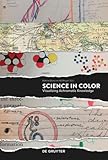Science in Color : Visualizing Achromatic Knowledge / ed. by Bettina Bock von Wülfingen.
Material type: TextPublisher: Berlin ; Boston : De Gruyter, [2019]Copyright date: ©2019Description: 1 online resource (239 p.)Content type:
TextPublisher: Berlin ; Boston : De Gruyter, [2019]Copyright date: ©2019Description: 1 online resource (239 p.)Content type: - 9783110604689
- 9783110605211
- 001.4226 23/ger
- online - DeGruyter
| Item type | Current library | Call number | URL | Status | Notes | Barcode | |
|---|---|---|---|---|---|---|---|
 eBook
eBook
|
Biblioteca "Angelicum" Pont. Univ. S.Tommaso d'Aquino Nuvola online | online - DeGruyter (Browse shelf(Opens below)) | Online access | Not for loan (Accesso limitato) | Accesso per gli utenti autorizzati / Access for authorized users | (dgr)9783110605211 |
Browsing Biblioteca "Angelicum" Pont. Univ. S.Tommaso d'Aquino shelves, Shelving location: Nuvola online Close shelf browser (Hides shelf browser)

|

|

|

|

|

|

|
||
| online - DeGruyter Ökonomie und Bildmedien : Bilder als Ausdrucksressource zur Konstruktion von Wissen / | online - DeGruyter Doing Family in Second-Generation British Migration Literature / | online - DeGruyter Sanierung und Insolvenz aus Bankensicht / | online - DeGruyter Science in Color : Visualizing Achromatic Knowledge / | online - DeGruyter Balance : Figuren des Äquilibriums in den Kulturwissenschaften / | online - DeGruyter Scientific Conceptualization and Ontological Difference / | online - DeGruyter Kleine Schriften. Band 1 / |
Frontmatter -- TABLE OF CONTENTS -- Editorial -- COLOR AND ITS MEANING FOR THE SCIENCES -- Color in Medical Images -- Color as the Other? Absence and Reappearance of Chromophobia in Eighteenth-Century France -- Research on Color Matters: Towards a Modern Archaeology of Ancient Polychromies -- Do Signs Make Logic Colored? Tendencies Around 1900 and Earlier -- Coloring the Fourth Dimension? Coloring Polytopes and Complex Curves at the End of the Nineteenth Century -- Encoding Color: Between Perception and Signal -- MEANINGFUL COLORS IN THE SCIENCES -- Green Is Refreshing: Techniques, Technologies and Epistemologies of Nineteenth-Century Color Therapies -- Pigments, Natural History and Primary Qualities: How Orange Became a Color -- An Evaluation of Color Maps for Visual Data Exploration -- The Use of Color in Geographic Maps -- Historical and Scientific Note of Color Duplex Doppler Ultrasound and Imaging -- Diagrammatic Traditions: Color in Metabolic Maps -- Pink and Blue Science. A Gender History of Color in Psychology -- Image Credits -- Authors
restricted access online access with authorization star
http://purl.org/coar/access_right/c_16ec
Color makes its way into natural science images as early as the research process. It serves for self-reflection and for communication within the scientific community. However, color does not follow a standard in the natural sciences: its meaning is contingent, even though culturally conditioned. Digital publishing enhances the use of color in scientific publications; at the same time, globalization promotes the idea of universal color symbolism. This book investigates the function of color in historical and current visualizations for scientific purposes, its epistemic role as a tool, and its long neglect due to symbolic and gender-specific connotations. The publication thus closes a research gap in the natural sciences and the humanities.
Color makes its way into natural science images as early as the research process. It serves for self-reflection and for communication within the scientific community. However, color does not follow a standard in the natural sciences: its meaning is contingent, even though culturally conditioned. Digital publishing enhances the use of color in scientific publications; at the same time, globalization promotes the idea of universal color symbolism. This book investigates the function of color in historical and current visualizations for scientific purposes, its epistemic role as a tool, and its long neglect due to symbolic and gender-specific connotations. The publication thus helps to bridge a long standing research gap in the natural sciences and the humanities.
Mode of access: Internet via World Wide Web.
In English.
Description based on online resource; title from PDF title page (publisher's Web site, viewed 21. Jun 2021)


